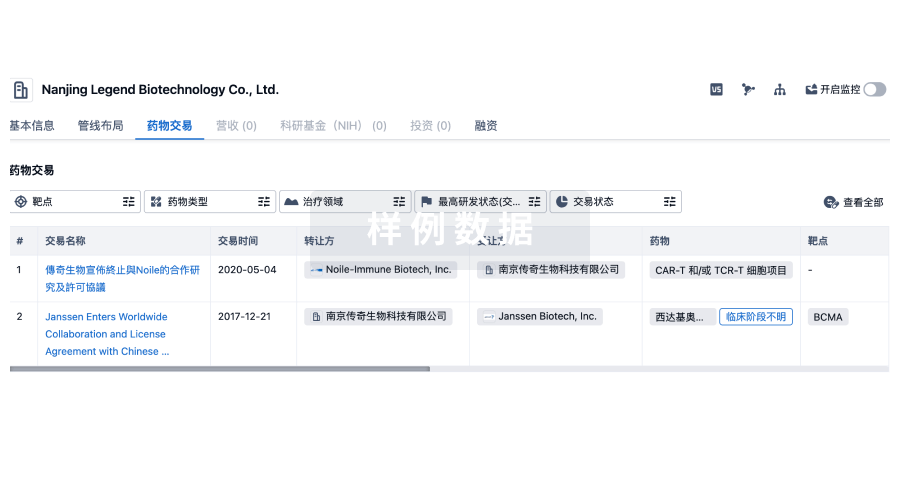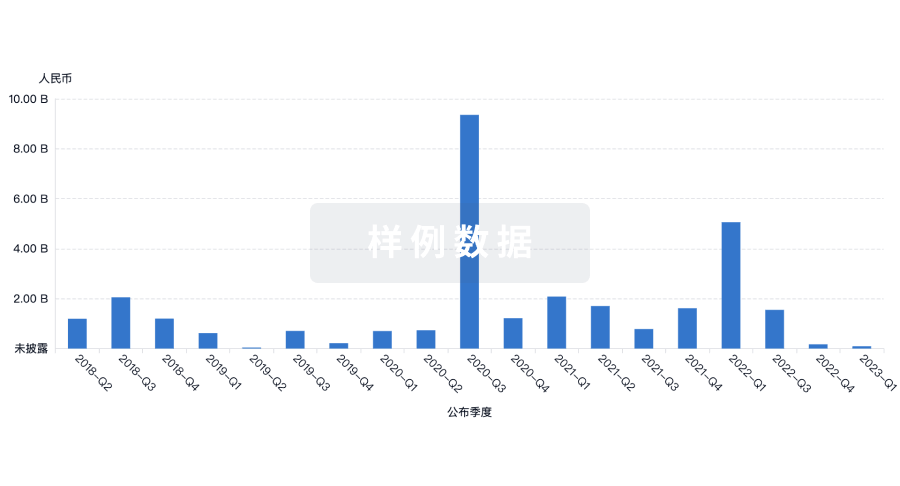预约演示
更新于:2025-12-07

The Trustees of Columbia University in The City of New York
更新于:2025-12-07
概览
标签
神经系统疾病
肿瘤
其他疾病
小分子化药
单克隆抗体
纳米抗体
疾病领域得分
一眼洞穿机构专注的疾病领域
暂无数据
技术平台
公司药物应用最多的技术
暂无数据
靶点
公司最常开发的靶点
暂无数据
| 排名前五的药物类型 | 数量 |
|---|---|
| 小分子化药 | 29 |
| 诊断用放射药物 | 5 |
| 腺相关病毒基因治疗 | 4 |
| 单克隆抗体 | 3 |
| 化学药 | 1 |
关联
48
项与 The Trustees of Columbia University in The City of New York 相关的药物靶点- |
作用机制 SPECT |
非在研适应症- |
最高研发阶段批准上市 |
首次获批国家/地区 美国 |
首次获批日期1974-05-28 |
靶点- |
作用机制 铁螯合剂 |
最高研发阶段批准上市 |
首次获批国家/地区 美国 |
首次获批日期1968-04-01 |
靶点 |
作用机制 ALDH2抑制剂 |
非在研适应症 |
最高研发阶段批准上市 |
首次获批国家/地区 美国 [+1] |
首次获批日期1951-08-28 |
5
项与 The Trustees of Columbia University in The City of New York 相关的临床试验NCT06793488
Neural Mechanisms of Anxiety During Early and Protracted Abstinence in Alcohol Use Disorder
The goal of this study is to better understand the underlying neurobiological basis of anxiety that emerges during abstinence in patients with alcohol use disorder (AUD). The main questions it aims to answer are:
1. To characterize anxiety itself as well as anxiety related-neurobiological circuitry in early abstinence in AUD
2. To examine how anxiety and anxiety related-neurobiological circuitry change over the course of abstinence in AUD
Researchers will recruit both participants with AUD and healthy volunteers.
The participants with AUD will be prescribed disulfiram, a medication that helps participants with AUD stay abstinent. Healthy volunteers will not receive antabuse. Patients with AUD will undergo fMRI scanning both after 1 week and 3 months of disulfiram treatment. Healthy volunteers will undergo fMRI once.
1. To characterize anxiety itself as well as anxiety related-neurobiological circuitry in early abstinence in AUD
2. To examine how anxiety and anxiety related-neurobiological circuitry change over the course of abstinence in AUD
Researchers will recruit both participants with AUD and healthy volunteers.
The participants with AUD will be prescribed disulfiram, a medication that helps participants with AUD stay abstinent. Healthy volunteers will not receive antabuse. Patients with AUD will undergo fMRI scanning both after 1 week and 3 months of disulfiram treatment. Healthy volunteers will undergo fMRI once.
开始日期2025-09-15 |
NCT06517628
The Heart Outcomes in Pregnancy Expectations for Mom and Baby Study
This is a prospective, observational study which is evaluating the obstetrical, neonatal, and cardiovascular outcomes of 1000 pregnant people with known heart disease to define how best to structure cardio-obstetrics care to optimize outcomes.
开始日期2025-01-14 |
申办/合作机构 |
NCT04519125
Effectiveness of the Use of Personal Protective Equipment in Addition to Tenofovir/Emtricitabine for the Prevention of the Transmission of SARS-COV-2 to Health Care Personnel. Randomized Clinical Trial
Effectiveness of the use of Tenofovir/Emtricitabine in addition to personal protective equipment for the prevention of the transmission of SARS-COV-2 to health care personnel. A Randomized Clinical Trial.
This is an experimental study whose aim is to evaluate the effectiveness of a drug to prevent infection with the virus that causes COVID-19 (SARS-CoV-2), in health care workers.
The drug under study is Tenofovir /Emtricitabine, a well-known antiretroviral, which is safe and is used as prophylaxis and treatment for HIV and other viral infections such as Hepatitis.
Several laboratory-based studies indicate that this drug has the potential to inhibit SARS-CoV-2 replication. In addition, one study in HIV infected persons found that those taking Tenofovir /Emtricitabine tended to have a lower occurrence of COVID-19.
In this study, we will compare the occurrence of infection with SARS-CoV-2/ COVID19 in health care workers between those assigned to an intervention group and those assigned to a control group. The intervention group will receive Tenofovir /Emtricitabine during 60 days in addition to the use of personal protective equipment (PPE), and the control group will receive a placebo during 60 days in addition to the use of personal protective equipment (PPE).
The study will recruit 950 health professionals above 18 and less than 70 years, working in the emergency room, COVID wards and intensive care units of seven hospitals in Colombia.
To make the comparison groups very similar, the participants will be assigned through a random mechanism to either the intervention (475), or the control (475) groups. In order to prevent biases in the evaluation of the results, neither the participants nor the clinical investigators, data managers, analysts and support personnel will know which intervention the participants are receiving.
To determine the occurrence of infection with the virus the study will use both molecular tests that detect the presence of viral genes in respiratory secretions, and serological tests that detect the response of the immune system to the virus. The study will evaluate also the safety of this drug determining the occurrence of adverse events.
This is an experimental study whose aim is to evaluate the effectiveness of a drug to prevent infection with the virus that causes COVID-19 (SARS-CoV-2), in health care workers.
The drug under study is Tenofovir /Emtricitabine, a well-known antiretroviral, which is safe and is used as prophylaxis and treatment for HIV and other viral infections such as Hepatitis.
Several laboratory-based studies indicate that this drug has the potential to inhibit SARS-CoV-2 replication. In addition, one study in HIV infected persons found that those taking Tenofovir /Emtricitabine tended to have a lower occurrence of COVID-19.
In this study, we will compare the occurrence of infection with SARS-CoV-2/ COVID19 in health care workers between those assigned to an intervention group and those assigned to a control group. The intervention group will receive Tenofovir /Emtricitabine during 60 days in addition to the use of personal protective equipment (PPE), and the control group will receive a placebo during 60 days in addition to the use of personal protective equipment (PPE).
The study will recruit 950 health professionals above 18 and less than 70 years, working in the emergency room, COVID wards and intensive care units of seven hospitals in Colombia.
To make the comparison groups very similar, the participants will be assigned through a random mechanism to either the intervention (475), or the control (475) groups. In order to prevent biases in the evaluation of the results, neither the participants nor the clinical investigators, data managers, analysts and support personnel will know which intervention the participants are receiving.
To determine the occurrence of infection with the virus the study will use both molecular tests that detect the presence of viral genes in respiratory secretions, and serological tests that detect the response of the immune system to the virus. The study will evaluate also the safety of this drug determining the occurrence of adverse events.
开始日期2020-08-30 |
申办/合作机构 |
100 项与 The Trustees of Columbia University in The City of New York 相关的临床结果
登录后查看更多信息
0 项与 The Trustees of Columbia University in The City of New York 相关的专利(医药)
登录后查看更多信息
67,803
项与 The Trustees of Columbia University in The City of New York 相关的文献(医药)2026-02-01·JOURNAL OF CRITICAL CARE
Sedation practices and associated clinical outcomes among adult ICU patients managed by advanced practice providers versus resident physicians
Article
作者: Peeler-Remy, Paula ; Dzierba, Amy L ; Brodie, Daniel ; Shah, Jenny ; Yip, Natalie ; Serra, Alexis L ; Beitler, Jeremy R ; Meier, Anne ; Muir, Justin
BACKGROUND:
Intensive care unit (ICU) staffing models increasingly use advanced practice providers (APPs), with unclear implications for clinical practice patterns. Sedation strategy is a modifiable determinant of clinical outcomes that might differ by staffing model.
METHODS:
This retrospective cohort study evaluated adults admitted to two medical ICUs in a quaternary teaching hospital, whose staffing differed only by APPs or residents. Patients requiring invasive ventilation for at least 48 h were included. The primary outcome was association of staffing model with sedative exposure during the first week of mechanical ventilation. Time to extubation and vital status at discharge were also assessed.
RESULTS:
Of 337 included patients, 96 % received continuous sedation on the day of intubation. Admission to the APP ICU was associated with significantly lower benzodiazepine exposure (adjusted OR 0.63; 95 % CI 0.40-0.99; p = 0.04) and higher propofol exposure (adjusted OR 1.73; 95 % CI 1.07-2.79; p = 0.03) on day of intubation. Cumulative benzodiazepine and opioid exposures over the first week after intubation were significantly less, and cumulative propofol exposure significantly more in the APP ICU despite similar sedation depth achieved between ICUs. Receipt of propofol on the first day was associated with shorter time to extubation (adjusted HR 1.45, 95 % CI 1.07-1.98; p = 0.02) and lower in-hospital mortality (adjusted OR 0.55, 95 % CI 0.33-0.93; p = 0.02).
CONCLUSION:
Patients admitted to an APP-staffed ICU were more likely to have sedation management reflective of best practice, and this practice was associated with shorter time to extubation and lower mortality.
2026-02-01·JOURNAL OF CRITICAL CARE
Endothelial dysfunction in critically ill patients with sepsis and COVID-19 using the albumin transudation rate: A pilot study
Article
作者: Khanna, Ashish K ; Bakker, Jan ; Castro, Ricardo ; Schreiber, Martin
BACKGROUND:
COVID-19, sepsis, and septic shock are associated with significant endothelial dysfunction and capillary leakage, posing diagnostic and management challenges in critically ill patients. Capillary leakage, as reflected by the albumin transudation rate (ATR), may have implications for fluid dynamics and patient outcomes in these conditions. We sought to describe and compare ATR in these two related pathologies, but clinically distinct conditions.
METHODS:
This study was conducted in 2022 across three ICUs and included 36 patients (18 with COVID-19 and 18 with sepsis). The local ethical committees approved the study. ATR, total blood volume (TBV), red blood cell volume (RBCV), and plasma volume (PV) were measured at multiple time points (Days 1, 2, 3, 7, and 10) using a 131I-albumin tracer. Data were analyzed using the non-parametric Wilcoxon rank-sum test and multivariate linear regression to identify predictors of ATR.
RESULTS:
ATR was significantly higher in patients with sepsis compared to those with COVID-19 throughout the ICU stay, despite lower admission severity scores in the sepsis group. Clinical assessments of the volume status frequently misclassify TBV in patients with COVID-19 or sepsis. Patients were often deemed hypervolemic when, by objective measures, they were hypovolemic under both conditions.
CONCLUSION:
ATR was persistently elevated in critically ill patients with sepsis and COVID-19. Sepsis exhibited significantly higher ATR values, suggesting a more pronounced endothelial dysfunction. There is a frequent inaccuracy in clinical fluid status assessment, which demands more reliable diagnostic tools to better guide fluid therapy in critically ill patients.
2026-01-01·JOURNAL OF NEUROSURGICAL ANESTHESIOLOGY
Intraoperative Burst Suppression by Analysis of Raw Electroencephalogram Postoperative Delirium in Older Adults Undergoing Spine Surgery: A Retrospective Cohort Study
Article
作者: García, Paul S. ; Barreto Chang, Odmara L. ; Zhou, Sara ; Kreuzer, Matthias ; Wise, Amy ; Duarte, Karina ; Pawar, Niti
Background::
Postoperative delirium is a common complication in older adults, associated with poor outcomes, morbidity, mortality, and higher health care costs. Older age is a strong predictor of delirium. Intraoperative burst suppression on the electroencephalogram (EEG) has also been linked to postoperative delirium and poor neurocognitive outcomes.
Methods::
In this a secondary analysis of data from the Perioperative Anesthesia Neurocognitive Disorder Assessment-Geriatric (PANDA-G) observational study, the raw EEGs of 239 spine surgery patients were evaluated. Associations between delirium and age, device-generated burst suppression ratio, and visual detection of the raw EEG were compared.
Results::
Demographics and anesthesia durations were similar in patients with and without delirium. There was a higher incidence of burst suppression identified by analysis of the raw EEG in the delirium group than in the no delirium group (73.45% vs. 50.9%;
P
=0.001) which appeared to be driven largely by a higher incidence of burst suppression during maintenance of anesthesia (67.2% vs. 46.3%;
P
=0.004). Burst suppression was more strongly associated with delirium than with age; estimated linear regression coefficient for burst suppression 0.182 (SE: 0.057;
P
=0.002) and for age 0.009 (SE: 0.005;
P
=0.082). There was no significant interaction between burst suppression and age (−0.512; SE: 0.390;
P
=0.190). Compared with visual detection of burst suppression, the burst suppression ratio overestimated burst suppression at low values, and underestimated burst suppression at high values.
Conclusion::
Intraoperative burst suppression identified by visual analysis of the EEG was more strongly associated with delirium than age in older adults undergoing spine surgery. Further research is needed to determine the clinical importance of these findings.
879
项与 The Trustees of Columbia University in The City of New York 相关的新闻(医药)2025-12-04
·百度百家
AlphaFold颠覆生物界!5年引用4万次,免费开源后助中国团队突破
维也纳分子病理学研究所的安德里亚·保利盯着电脑屏幕,困扰她近十年的谜题终于有了答案。屏幕上不是传统X射线衍射实验的结果,而是AlphaFold预测出的Tmem81蛋白模型——精确到原子级别的三维结构。这个模型直接指出了精子与卵子融合的关键机制。
这只是全球近4万篇引用AlphaFold论文的研究之一。五年前,谷歌DeepMind推出的这款AI工具仅凭氨基酸序列就能预测出接近实验精度的蛋白质三维结构,在CASP14蛋白质结构预测竞赛中一鸣惊人。现在,它已经从一项技术创新变成了全球科研基础设施的一部分。
从实验室到全世界,一场静悄悄的革命
传统解析一个蛋白质的三维结构,得先培养蛋白质晶体,然后用X射线轰击,再通过复杂计算反推出结构。这个过程不仅耗时数月甚至数年,还需要价值数百万美元的设备和高度专业化的技术人员。很多实验室光是这一步就卡住了。
AlphaFold的出现彻底改变了游戏规则。DeepMind与欧洲生物信息研究所合作推出的AlphaFold蛋白质结构数据库,向全球免费开放超过2.4亿个蛋白质结构预测,涵盖地球上几乎所有已知蛋白质。这种知识获取的民主化在历史上极为罕见——将高质量结构预测的门槛降低到只需一台联网电脑。
数据显示,该数据库已被190多个国家的约330万名研究人员使用,其中包括100多万来自中低收入国家的用户。在土耳其,两位本科生Alper和TanerKaragöl在疫情期间利用在线教程自学结构生物学,在无任何先前培训的情况下,目前已发表15篇研究论文。这在过去是不可想象的。
牛津大学团队利用它预测疟疾关键蛋白Pfs48/45的全长结构,为新型疫苗设计提供参考。欧洲科学家利用AlphaFold解析了蜜蜂的关键免疫蛋白卵黄原蛋白,这些结构洞察正用于濒危蜂群的保护工作,并指导AI辅助育种计划。
中国团队的突破,从几年缩短到几天
上个月,国内知名科研团队在《细胞》子刊上发表了一项关于罕见遗传病的研究。该团队利用AlphaFold3模拟了一个与神经系统发育相关蛋白的突变体结构,快速定位了致病机理,为后续干预方案提供了关键线索。
团队负责人表示,若按传统实验方法,仅结构解析就可能耗时一两年,而现在通过AI预测,他们能在几天内获得可靠结构模型,将研究重点迅速转向机理验证和治疗探索。
保利团队的经历更能说明问题。她在斑马鱼受精机制研究中发现了关键蛋白Bouncer,但无法确定其作用机制。AlphaFold-Multimer预测显示,Tmem81蛋白能够稳定精子蛋白复合物并为Bouncer创造结合位点。这一预测随后被实验证实,相关研究成果于去年10月发表在《细胞》杂志上。"AlphaFold加速了发现进程,我们的每个项目都会用到它,"保利说。
量化研究显示,使用AlphaFold的结构生物学家向蛋白质数据库提交的结构数量比基线高出约50%。这意味着相同投入下,科研产出大幅增加。更重要的是,AI降低了科研门槛,让更多人能够参与到前沿研究中来。
诺奖只是开始,商业价值远超想象
AlphaFold的影响力在去年获得了最高认可——其开发团队因解决"生物学50年重大挑战"获得诺贝尔化学奖。但真正展示其商业价值的,是DeepMind在2021年拆分成立的IsomorphicLabs。
这家专注于人工智能药物研发的公司在今年4月完成了首轮6亿美元外部融资,由ThriveCapital领投,成为当年生物医药领域金额最高的单轮融资。此前,IsomorphicLabs已与礼来和诺华两家制药巨头签订了总价值近30亿美元的合作协议,利用AlphaFold技术加速新药开发。
这些数字背后是制药行业对AI药物设计的信心转变。传统药物开发平均需要10至15年时间和数十亿美元投资,而IsomorphicLabs开发的药物设计引擎覆盖药物发现全生命周期,能够将早期开发阶段的成本削减30%至40%,周期缩短一年以上。
今年诺华宣布扩大合作范围,在原有三个靶点基础上新增最多三个研究项目,表明初步合作已显示出实际成效。动脉粥样硬化是全球死亡的主要原因,数十年来,低密度脂蛋白中的核心蛋白载脂蛋白B100结构一直难以捉摸。AlphaFold2揭示了其复杂的笼状形状,为药物研究人员设计新型预防疗法提供了原子层面的细节。
技术迭代不停,边界还在拓展
去年5月发布的AlphaFold3进一步扩展了技术边界。与只能预测蛋白质结构的前代不同,AlphaFold3可以预测生命中所有分子的结构和相互作用——不仅是蛋白质,还包括DNA、RNA和配体等小分子。它能生成整个分子复合物的三维结构,全面展示潜在药物分子如何与靶蛋白结合。
这种能力对药物发现至关重要。大多数药物都是通过与特定蛋白质结合来发挥作用的,而理解候选药物如何与靶蛋白相互作用是优化药效和减少副作用的基础。AlphaFold3在预测药物-蛋白相互作用方面的准确性显著提升,某些案例中甚至能准确预测小分子结合口袋的精细细节。
值得一提的是,AlphaFold3在去年11月宣布开源,科学家们可以下载其底层代码并将其应用于非商业领域。这一决定平衡了商业利益与科学开放性,使得学术研究能够继续推进我们对疾病机制和药物相互作用的理解。截至目前,AlphaFold服务器已帮助全球数千名研究人员完成超过800万次结构和相互作用预测。
AlphaFold的成功激发了一系列相关模型的诞生。AlphaGenome专注于解读人类基因非编码序列的功能,AlphaMissense预测基因错义突变的致病性,AlphaProteo可以设计新型高强度蛋白质结合剂,靶向与癌症和糖尿病相关的分子。
结语
哥伦比亚大学计算生物学家穆罕默德·阿尔库雷希回忆,AlphaFold2发布后从事蛋白质结构预测的学术研究人员经历了"生存危机",感觉核心问题已被解决。但随后这一工具催生了全新的研究方向——AI驱动的蛋白质从头设计、抗体工程、酶催化机制研究等领域涌现大量机会和资金。"现在是成为计算生物学家的好时机,"阿尔库雷希说。
五年时间,AlphaFold从一个实验室项目演变为全球科研基础设施,从学术工具转变为商业引擎,从单一技术突破发展为系列创新平台。4万次引用只是这一转变的表面指标,真正的影响在于它如何永久性地改变了科学家思考和解决问题的方式。
当人工智能能够在分钟内完成过去需要数年的工作时,科学研究的瓶颈从数据获取转移到了创意生成和假设验证,这本身就是一个范式转变。AlphaFold的故事证明,当技术足够强大且足够开放时,它能够释放出远超其原始设计目标的价值。真正的检验将在那些原本被认为不可成药的靶点被成功开发成药物、那些困扰几十年的生物学机制因为结构洞见而突然明朗的时刻到来。届时,诺贝尔奖可能只是这场革命的开始而非终点。
疫苗
2025-12-03
·金色财经
整理:金色财经YZi Labs官方在社交媒体发文,公布了EASY Residency第二季的孵化项目。YZi Labs表示第二季汇聚了在Web3、人工智能和生物技术领域进行开发的初创项目,体现了YZi Labs的信念,即未来十年将由三大力量的融合所塑造:区块链将释放所有权、可扩展性和全球流动性。人工智能将加速创造力、劳动力和智能的发展。生物技术助力延长健康寿命YZi Labs和EASY Residency支持那些创造突破性技术并大规模解锁全球分销的项目——从人工智能驱动的药物研发和机器人自动化到为代币化未来提供支持的金融和基础设施。以下是第二季孵化项目的具体名单:42.space:交易诸如Meme币之类的现实世界事件。项目团队:Leo Zhang(创始人):前纽约加密货币基金研究主管;曾任职于KKR和摩根士丹利股票衍生品部门;斯坦福大学数学学士Steve Kim(CTO):多家创业公司的创始工程师(曾参与沃尔玛/Discord等公司);斯坦福大学计算机科学学士Aleksi Ollikainen-Read(战略/运营/法律):前 Consensys SMG 战略与运营主管;曾在牛津大学教授法律;哈佛大学/马克斯·普朗克研究所研究员;英格兰和威尔士律师协会会员(2018 年)。投资理由:42.space是一种资产发行协议,它显著拓宽了预测市场的范围。通过结合曲线将结果构建为代币发行平台,42.space允许用户创建和交易与现实世界事件相关的资产。交易方式如同流动性代币;结算方式如同预测市场。这一创新机制由一支实力雄厚的团队打造,该团队由斯坦福大学和哈佛大学的校友以及华尔街资深人士组成,融合了顶尖的工程技术和高水平的金融策略。与BNB Chain合作,42.space通过向庞大的用户群体引入新颖的、基于事件的资产,拓展了DeFi的视野。4D Labs:空间智能大模型的数据收集、模型开发及应用项目团队:Bruce Bai(CEO):浙江大学博士;连续创业者,曾创办过两家计算机视觉初创公司。Ian Y. Xu(联合创始人):密歇根大学博士后;香港中文大学博士;前 Meta Reality Labs 和商汤科技员工。Xin Zhou(联合创始人):百度美国首席人工智能架构师;密歇根大学博士;拥有 10 多年人工智能/基因人工智能系统领导经验。Haoming(联合创始人):北京大学博士后;浙江大学博士;前百度员工;发表过 10 多篇顶级人工智能论文;多次创业(Deep Pink Elephant、xPerception,后者已被百度收购)。投资理由:4D Labs融合了人工智能、3D和Web3技术,致力于解决空间计算时代的基础性瓶颈:可扩展、可验证的高质量3D数据。其空间大型模型和3D数据生成/采集流程,结合代币化数据版权框架,使其成为3D数据基础设施领域的先行者。随着数字孪生和具身人工智能的加速发展,以所有权为支撑的3D数据网络将变得至关重要——因此,对4D Labs的投资是面向下一代计算范式基础层的及时且具有战略意义的举措。AllScale:轻量级自托管式跨境业务新银行项目团队:Shawn Pang(CEO):前TikTok和Capital One支付部门负责人;连续创业者;前KuCoin上市负责人。Leo Wang(COO):前亚马逊、IBM、Scotiabank高管;金融科技和基础设施建设者。Alisha Li(CMO):前Fenghou Capital合伙人,前惠普/戴尔/Sun销售总监。Khalil Lin(合规):持有纽约州律师执照;前Kraken、The Block成员。投资理由:AllScale正在构建一个自托管的稳定币新银行,以合规且直观的方式为企业简化支付、薪资和发票流程。投资AllScale是基于其产品与市场高度契合的早期迹象,以及自然增长和稳健的用户留存率。AllScale将稳定币的速度和透明度与符合现代企业运营和合规需求的用户体验相结合,因此具备抢占市场份额的优势。Advent:人工智能驱动的精准基因治疗平台项目团队:Bonnie Zhu:香港科技大学化学及生物工程系助理教授;斯坦福大学博士。Kai Liu :香港科技大学教授,神经科学领军人物。Yuan Yao:斯坦福大学生物工程博士,现任贝克顿·迪金森公司血液透析和腹膜透析销售与市场总监。投资理由:Advent在细胞和基因治疗递送领域处于领先地位,利用其专有的病毒蛋白数据集和专门构建的AI驱动平台,将腺相关病毒(AAV)衣壳的发现周期从数月缩短至数周。其内部高通量数据、可扩展的差异化衣壳知识产权管线以及性能优于天然血清型的合成衣壳,在快速增长的市场中构建了坚实的技术护城河。凭借强大的团队和清晰的技术差异化优势,Advent代表着一个与细胞和基因治疗(CGT)市场主要先例相符的、恰逢其时的入场良机。AgriDynamics:解决农场劳动力危机的水果采摘机器人项目团队:Dr. Zhaojian Li(CTO):密歇根州立大学红杉杰出副教授,领导通过美国国家科学基金会和美国农业部资助开发的专利模块化苹果采摘机器人的商业化。Kyle Lammers(CEO):致力于苹果采摘机器人的研发;曾荣获密歇根州农业生物创新奖、美国农业与生物工程师协会(ASABE)最佳学生演讲奖和信息技术服务社区最佳论文奖。投资理由:AgriDynamics通过一项已获专利、经过实地验证的机器人平台,解决了美国特种农业中最棘手的成本和劳动力挑战——苹果采摘。在苹果采摘中,劳动力成本约占生产成本的70%。该平台已获得主要种植者协会的认可。其模块化、商业化且具有可防御性的知识产权,使其在价值数十亿美元的市场中拥有明显的先发优势。凭借可扩展的路线图,该公司有望拓展至其他高价值作物,并实现持续的服务/软件收入,从而成为特种农业的核心自动化基础设施。Bento.fun:预测市场的社交层项目团队:Abhitej Singh(CEO):前Persistence/pSTAKE增长主管;联合创立Cosmos India;创立Filament(交易额1亿美元,融资115万美元)Pratyaksh Inani(CPO):13岁从事量化交易;曾任Persistence财资/产品经理;Filament联合创始人。Rajeeb Kumar(工程师)——前Nethermind员工,印度理工学院毕业生,6年DeFi/合约工程经验,10次黑客马拉松冠军。投资理由:Bento将Telegram、Twitter和WhatsApp上的日常粉丝讨论转化为1-10美元的微型对决,采用简单快捷的形式,开辟了一个拥有巨大交易量潜力的休闲粉丝群体。创始人拥有深厚的行业经验,目标客户是板球和F1等高流量的全球粉丝群体。作为BNB Chain的原生预测市场,Bento与我们的生态系统战略高度契合,并通过低摩擦的社交投注方式推动更广泛的链上参与。FingerDance:为聋哑人提供手语翻译的人工智能基础设施项目团队:Kevin Gong(联合创始人):新加坡国立大学商业分析硕士;Miracle Plus研究员。Alex Xu(联合创始人):北京大学计算机科学博士;Enzo Xu(联合创始人):宾夕法尼亚大学计算机与信息科学硕士。投资理由:手语是全球聋哑人社群的第一语言,但由于手语翻译人员严重短缺,信息获取仍然受到限制。FingerDance直面这一服务不足的市场。通过部署最先进的手语大型语言模型(SL-LLM),FingerDance利用人工智能提供实时、可扩展的翻译服务,这是人工翻译基础设施无法比拟的。凭借五年与聋哑人社群的紧密合作,该团队拥有独特的优势,有望彻底改变沟通无障碍的现状。Frontrun:为快速发现、尽职调查和执行而打造的专业交易员钱包。项目团队:Chris(创始人/CEO):前Robinhood Crypto(构建了存款/取款功能),Sui创始工程师(领导8人团队构建浏览器、SDK、RPC和拥有100多万用户的钱包)。投资理由:Frontrun是一款以交易者为中心的钱包,旨在实现快速发现、尽职调查和无缝执行,直接解决高频交易者面临的明确痛点。早期自然增长和高留存率验证了该产品与极具吸引力的初始目标群体——价值数十亿美元市场规模(仅Solana的年度手续费就超过10亿美元)中的高价值交易者群体的契合度。其多链路线图以及与BNB Chain DeFi生态系统的契合度,使Frontrun成为更广泛的交易基础设施中具有战略意义的补充。Help.fun:非营利代币的加密货币启动平台项目团队:Helena Everley(联合创始人):斯坦福大学本科生。Arash Attar(联合创始人兼CTO):曾开发速度最快的Meme币移动交易应用程序之一,并开发过高性能的球鞋机器人。投资理由:Help.fun正在构建加密原生筹款平台,使非营利组织和初创公司能够以公平、防机器人的方式发行慈善代币,从而解决链上筹款长期存在的诚信问题。其反狙击机制(诱饵、谜题、gas陷阱)确保了公平参与,并为掠夺性的Meme代币发行提供了一种可靠的替代方案。早期执行力强劲,并与BNB Chain的文化和流动性状况高度契合。Help.fun作为以使命为导向的组织的可扩展链上筹款工具。Hertzflow:任何资产无需许可的杠杆交易市场项目团队:Vincent Shang(联合创始人):超过10年的加密货币从业经验,最具影响力的CT KOL之一。Hero(联合创始人兼产品负责人):此前在Coinbase参与CDP和Prime MPC钱包的开发。Soren(技术主管):Mantle核心开发人员(早期工程团队,从零开始组建)。投资理由:Hertzflow致力于消除日交易额高达4.5万亿美元的传统零售衍生品市场与链上经济之间的鸿沟。该协议由一支在传统衍生品领域拥有深厚专业知识的团队领导,旨在吸引庞大的非加密货币原生交易者用户群体。Hertzflow是一款技术成熟的产品,运行于BNB Chain生态系统中,它将无需许可的链上结算的高效性与专为全球庞大交易市场量身定制的用户体验完美结合。Manifolds:基于人工智能的3D空间可控视频生成平台项目团队:Qingyuan Shan(CEO):Heywhale前高级副总裁;太阳川河前企业战略主管;布法罗大学数学学士,哥伦比亚大学应用分析硕士。Yudong Tao(CTO):Meta前研究数据科学家;复旦大学电子工程学士,迈阿密大学计算机工程博士。Naiyuan Huang(COO):Heywhale前销售与市场营销主管;中欧国际工商学院校友;曾成功拓展中国第二大人工智能人才社区。投资理由:Manifolds专注于可控的3D感知AI视频,将其作为下一代内容创作和具身AI应用的赋能层。其技术差异化优势——包括3D空间生成、物理感知模拟、混合渲染以及精细的物体/相机控制——使其在电子商务可视化和现实世界集成AI系统等高增长垂直领域占据优势。早期强劲的增长势头(年经常性收入达15万美元,在未进行付费营销的情况下获得60家付费企业客户)表明其产品已具备成熟的开发能力、可扩展的潜力以及创始人与市场的高度契合度。MeleeMon:使用稳定币进行投注的竞技性手机游戏项目团队:Alex(CEO):连续四年位列宝可梦竞技选手前500名;创始人与市场高度契合。Jasper(CTO):6年以上Unity和React开发经验。投资理由:MeleeMon是一款移动端技巧型怪兽对战游戏,其团队拥有强大的创始人市场契合度——他们曾获得YC投资,拥有丰富的游戏开发经验(其前公司Gamebytes拥有超过500万用户),在宝可梦竞技领域拥有深厚的信誉,并对区块链增强型游戏经济有着清晰的理解。该项目瞄准了规模庞大且成熟的Web2博彩游戏市场,同时在链上引入了全新的竞技游戏循环。YZi Labs致力于在BNB Chain上打造高质量、趣味十足的游戏体验,而MeleeMon凭借其可靠的执行能力,与YZi Labs的战略高度契合。Neomera BioLab:药物研发平台,为慢性疼痛和重大慢性疾病提供更好的非阿片类药物疗法。项目团队:Rebecca Miao(CEO):药物开发领域15年以上经验;曾任AKSO Bio首席科学官;领导多个获得FDA批准的IND;促成了一项价值7500万美元的制药合作;拥有200多项专利;斯坦福大学博士后。Jimmy Xu(CTO):约翰·霍普金斯大学理学学士;斯坦福大学生物工程博士/博士后;药物筛选优化和生物医学人工智能专家。Yi Lu(CFO):从投资者转型为连续创业者,从概念到试验打造新型疼痛疗法,获得国际顶级出版物和奖项;拥有斯坦福大学工商管理硕士学位;曾就职于贝恩资本和马德龙资本合伙人。投资理由:Neomera致力于解决全球超过10亿慢性疼痛患者迫切需要的非成瘾性镇痛疗法。其以生物学为先导、人工智能加速的发现平台拥有显著优势:能够生成专有的、高度相关的内部数据,并成功针对传统方法无法解决的适应症。这种紧密整合的湿实验室+机器学习循环,从根本上缩短了高达80%的实验周期,从而为针对难治性慢性疾病的快速药物开发构建了一个可扩展、差异化的引擎。Sats Terminal:比特币原生流动性协议项目团队:Stan Havryliuk(CEO):曾在Bitcoin.com、ZondaCrypto和Ambisafe担任高级领导职务;曾将多个团队规模 从5人扩展至 50 人。Rishabh Java(CTO):连续创业的金融科技公司创始人,打造多款比特币产品;曾任Ordinals Council、ToshiPad和Crackedevs首席技术官。投资理由:Sats Terminal基于比特币和EVM链(主要是BNB和Base),在一个由比特币抵押贷款、收益和交易需求不断增长驱动的庞大且不断扩张的市场中运营。他们最初以聚合互换模式进入市场,并迅速积累了可观的B2B用户群(占Runes所有交易的75%;集成超过30个平台),现在正以强劲的初期势头拓展比特币信贷和收益市场。早期机构投资包括由Coinbase Ventures和Draper Associates领投的170万美元种子前融资。Saturn Labs:10%+收益率,由比特币信贷支持项目团队:Kevin Li(联合创始人兼CEO):ParaFi联合创始人;前Artemis DAT负责人Sebastian Melendez(联合创始人兼CTO):联合创始人,前 Artemis稳定币负责人Ellis Osborn(联合创始人兼COO):宾夕法尼亚大学区块链负责人;前M31 Capital投资人。投资理由:Saturn Labs正在构建一种收益率超过10%的稳定币,其核心技术是MicroStrategy的STRC,一种透明且具有机构信誉的比特币信用工具。Saturn融合了稳定币、DAT和RWA三大领域,而这三大领域正是加密货币领域增长最快的。市场对透明、可扩展且具有实际收益的储备的需求正在加速增长,而Saturn的创始团队在DAT、DeFi和稳定币架构方面拥有丰富的经验,这使得Saturn有望成为链上经济的核心层。Predict.fun:利用DeFi增强的流动性解决资本效率低下问题的预测市场项目团队:Ding:曾从事咨询/投资银行业务;2017年加入币安并组建研究与上市团队;领导Binance Launchpad(2019年);创立 PancakeSwap(2020年);联合创立Predict.fun(2024年)。投资理由:Predict.fun通过将事件交易转化为一种能够产生收益、支持杠杆、且可自行托管的金融基础,催生了一类全新的主流预测市场,使用户能够在参与其中的同时充分体验去中心化金融(DeFi)。通过集成DeFi原生收益、无缝的链上用户体验(AA、无gas费交易)以及可组合性,该协议降低了用户采用的门槛,并将预测市场定位为面向更广泛的非加密货币原生用户群体的、易于使用且实用性强的产品。Trellis Robotics:具备人工智能的软体机器人平台,解锁难以触及的工业资产项目团队:Yimeng Qin(CEO):斯坦福大学机械工程博士候选人;核心藤蔓机器人技术的首席开发者(将于2026年3月完成学业)。Elvy Yao(COO):斯坦福大学机械工程硕士(2025年12月毕业);Trellis平台传感器外壳、转向和机电一体化的主要贡献者。William Heap(技术负责人):斯坦福大学机械工程博士候选人(2028 年后全职);2019年以来一直在加州大学圣巴巴拉分校和斯坦福大学从事藤蔓机器人系统的研究。投资理由:Trellis Robotics致力于解决工业运营中最具成本和危险性的挑战之一:密闭空间基础设施的检测。其独特的藤蔓机器人平台能够提供人类检测人员和现有工具无法比拟的精度、覆盖范围和安全性,从而在庞大且服务不足的市场中建立起清晰的竞争优势。早期验证——包括与陶氏化学和劳伦斯伯克利国家实验室的试点项目,以及巴斯夫、拜耳和雪佛龙等公司的浓厚兴趣——表明市场需求强劲,并具备实现企业级应用的可靠路径。
并购
2025-12-02
Belite Bio是一家专注于推进新型疗法研发的临床阶段药物开发公司,致力于治疗存在重大未满足医疗需求的退行性视网膜疾病,例如晚期干性年龄相关性黄斑变性(AMD)中的STGD1(一种遗传性视网膜退行性疾病)和GA(地图样萎缩),以及特定的代谢性疾病。Belite的主要候选药物Tinlarebant(RBP4拮抗剂)是一种口服疗法,旨在减少双视黄醇毒素在眼内的积累。
尽管Belite三年前首次公开募股仅筹集了3600万美元,但此后一直悄然成为生物制药行业表现最佳的公司之一。该公司股票首发价格为每股6美元,周一开盘价接近140美元。Belite目前的市值约为50亿美元。
原因在于tinlarebant,一种口服药物,有望成为首个上市的治疗Stargardt病的药物。Stargardt病是一种基因缺陷,会改变人体处理用于生成视网膜细胞的维生素A的方式。这种缺陷会导致眼睛中形成黄色团块,破坏细胞并引发进行性视力丧失。据Belite估计,美国约有5万人患有这种疾病,目前尚无有效的治疗方法。
Tinlarebant旨在减少眼内有毒维生素A代谢产物的积累。该药物十多年前由哥伦比亚大学首次进行研究,随后于2016年在美国国立卫生研究院(NIH)的一个项目中公开招标。两年后,Belite公司的首席执行官兼董事长Tom Lin获得了该药物的授权,并围绕该项目成立了Belite公司。此后,Belite公司已将tinlarebant推进至Stargardt综合征和地图样萎缩(一种更常见的视力丧失类型)的后期临床试验阶段。
今年早些时候,由于预期Stargardt试验结果即将公布,Belite的市值已经翻了一番。该公司还收到了试验监察员的积极建议,认为这项包含104名患者的研究可以继续进行,无需任何修改。此外,该公司还注意到,中国药品监管机构已开始审查一项基于中期结果的申请,这些结果显示该研究的主要指标具有统计学意义。Leerink Partners分析师Marc Goodman上个月撰文指出,鉴于这些最新进展,该试验成功的可能性“相当高”。Goodman预测,该药物的年销售峰值将在14亿美元至36亿美元之间,具体金额取决于药物的定价。
鉴于取得的积极成果,Belite计划于2026年上半年与美国及其他地区的监管机构讨论审批申请。然而,该公司可能很快就会面临竞争。Alkeus Pharmaceuticals正在准备提交一种新药的申请,该药的设计理念与Belite类似,旨在减少眼部有害维生素A副产物的积累。此外,Ocugen、AAVantgarde、Splice Bio等公司也在推进针对该疾病的基因药物研发。
瑞穗证券的格雷格·苏瓦纳维赫写道,斯塔加特研究所的专家认为,基因疗法最终将成为治疗这种疾病的“首选疗法”。但他在11月份撰文指出,就目前而言,由于缺乏其他可用的疗法,这种已被证明能够延缓疾病进展的药物应该会受到“市场的热烈追捧”。
Belite股价周一早盘一度上涨两位数,随后逆转下跌几个百分点。
2025年11月2日英国药品和保健产品监管署(MHRA)同意受理 Tinlarebant用于治疗Stargardt病的有条件上市许可申请。
2025年10月15日美国国家药品监督管理局药物评价中心同意优先审评tinlarebant治疗Stargardt病的NDA申请。
2025年9月12日Belite Bio完成了针对Stargardt病(青少年、成人)的 III 期 DRAGON 试验,试验地点包括美国、英国、德国、法国、比利时、瑞士、荷兰、中国、香港、台湾和澳大利亚(NCT05244304)。
2025年12月1日(GLOBE NEWSWIRE)—— Belite Bio公司(纳斯达克股票代码:BLTE)(简称“Belite Bio”或“公司”)今日公布了Tinlarebant全球3期“DRAGON”试验的主要结果,这是首个针对1型斯塔加特病(STGD1)患者的关键性试验取得成功。STGD1是一种眼部疾病,会导致进行性视力丧失,通常始于儿童期或青年期,目前全球尚无获批的治疗方法。
DRAGON III期临床试验纳入了104例STGD1患者,并达到了其主要疗效终点,结果显示,与安慰剂组相比,治疗组视网膜病变的生长速度显著降低36%,该降低通过眼底自发荧光成像测量,表现为自发荧光强度明显降低(DDAF)。采用预设分析方法后,结果具有统计学意义(p值=0.0033)。考虑到STGD1的进展性特征,进一步的事后分析提供了特定的数据相关性,结果显示治疗效果仍然显著(p值<0.0001)。
“DRAGON试验的最终结果标志着Stargardt病治疗领域的一项历史性突破,为首个潜在疗法的研发铺平了道路,并为长期以来饱受这种一度被认为无法治愈的疾病折磨的患者及其家人带来了新的希望,”Belite Bio董事长兼首席执行官Tom Lin博士表示。“Tinlarebant不仅被证实能够有效延缓视网膜退化,而且这也是首个口服疗法在视网膜退行性疾病中展现出具有临床意义的疗效。凭借这些数据,我们正在全球范围内推进监管方面的沟通,并朝着为Stargardt病患者提供首个获批疗法的目标迈进。我们衷心感谢所有患者、家属和研究人员,正是他们的奉献精神才成就了这一辉煌。”
“DRAGON研究中观察到的病灶生长显著减少,以及良好的安全性,为我们的治疗方法和Tinlarebant的作用机制提供了重要的验证。这些结果凸显了团队致力于解决Stargardt病未满足的医疗需求,以及显著改善患者生活质量的潜力,”Belite Bio首席科学官Nathan Mata博士表示。
正如预期,在24个月的研究期间,两个研究组的视力总体变化均很小,与自然病程数据一致。安全性与公司此前报告的结果一致,Tinlarebant耐受性良好,仅有4例因治疗相关原因而停止治疗。待全面分析完成后,公司计划在即将召开的医学会议上分享更多数据。
“看到控制良好的三期临床试验数据显示,Stargardt病病灶生长明显减缓,这令人深感鼓舞,”英国摩菲尔德眼科医院的眼科顾问医师、DRAGON试验的主要研究者和主要入组者之一、英国皇家眼科医师学会会员Michel Michaelides教授表示,“鉴于这些发现的可靠性和一致性,我们相信,对于饱受这种毁灭性疾病折磨的患者来说,获批的治疗方案指日可待。”
“DRAGON试验取得了令人瞩目的成果,我们或许很快就能迎来首个治疗Stargardt病的药物——Tinlarebant,”斯坦福大学拜尔斯眼科研究所眼科教授、斯坦福大学医学院内科和儿科教授Quan Dong Nguyen医学博士、理学硕士、美国眼科学会会员、美国视网膜和眼科研究学会会员、美国放射学会会员指出。“病灶生长减缓的现象很快就会转化为视觉功能的显著改善。此前的研究表明,如果不进行治疗,Stargardt病引起的病灶进行性增大预计会损害视力和视野。Tinlarebant已被证实能够显著减缓病灶生长。”
“DRAGON试验提供了迄今为止最有力的证据,证明口服疗法可以改变Stargardt病的病程,”Belite Bio首席医疗官Hendrik Scholl博士表示。“这些结果验证了Tinlarebant研发背后的科学方法,表明减少视网膜中毒性副产物的积累可以显著延缓疾病进展。Tinlarebant不仅在研究眼,而且在双眼中,都对DDAF病变的生长速度产生了清晰且具有统计学意义的治疗效果。此外,关键次要终点也显示出具有统计学意义的获益,同样在双眼中均得到证实。DRAGON试验表明,Tinlarebant的安全性和耐受性非常好。总而言之,这些数据强化了Tinlarebant改变Stargardt病治疗格局的潜力,并为未来遗传性视网膜疾病的研究树立了新的标杆。”
公司计划与监管机构接洽,讨论下一步的潜在步骤,并于2026年上半年提交Tinlarebant的新药申请。Tinlarebant已在美国获得突破性疗法认定、快速通道认定和罕见儿科疾病认定;在美国、欧洲和日本获得孤儿药认定;并在日本获得STGD1的先导药物认定。
原研在中国进展情况:
相关专利信息:
发明类型
申请号
申请日期
标题
申请人
案件状态
组合物
CN202280089829.6
CN118574615A
2022.11.22
RBP4抑制剂的片剂制剂和使用方法
倍亮生物有限公司
等待实审提案
固体分散体,多晶型物,无定形
CN202080062716.8
CN114364382
2020.07.06
RBP4抑制剂的制剂和使用方法
倍亮生物有限责任公司
驳回失效
固体分散体,多晶型物
CN202411257178.4
(CN202080062716.8的分案申请)
2020.07.06
RBP4抑制剂的制剂和使用方法
倍亮生物有限责任公司
等待实审提案
治疗方法
CN202380047211.8
2023.04.11
用于评估视觉功能的方法、组合物和系统
英属开曼群岛商倍亮生物有限公司
等待实审提案
衍生物
CN201580036136.0
CN106794364
2015.04.29
取代的4‑苯基哌啶及其制备和用途
哥伦比亚大学董事会
有权
化合物
CN201911252390.0
CN111393434
2015.04.29
取代的4-苯基哌啶及其制备和用途
哥伦比亚大学董事会
有权
100 项与 The Trustees of Columbia University in The City of New York 相关的药物交易
登录后查看更多信息
100 项与 The Trustees of Columbia University in The City of New York 相关的转化医学
登录后查看更多信息
组织架构
使用我们的机构树数据加速您的研究。
登录
或

管线布局
2025年12月10日管线快照
管线布局中药物为当前组织机构及其子机构作为药物机构进行统计,早期临床1期并入临床1期,临床1/2期并入临床2期,临床2/3期并入临床3期
药物发现
13
29
临床前
临床1期
4
1
临床2期
其他
34
登录后查看更多信息
当前项目
| 药物(靶点) | 适应症 | 全球最高研发状态 |
|---|---|---|
(S,S)-[11C]Mener ( NET ) | 多发性硬化症 更多 | 临床2期 |
Tinlarebant ( RBP4 ) | 斯塔加特病 更多 | 临床1期 |
Selected CD34+ Cells(Ossium Health, Inc.) | 移植物抗宿主病 更多 | 临床1期 |
甲磺酸去铁胺 | 软脑膜转移性恶性肿瘤 更多 | 临床1期 |
双硫仑 ( ALDH2 ) | 酒精使用障碍 更多 | 早期临床1期 |
登录后查看更多信息
药物交易
使用我们的药物交易数据加速您的研究。
登录
或

转化医学
使用我们的转化医学数据加速您的研究。
登录
或

营收
使用 Synapse 探索超过 36 万个组织的财务状况。
登录
或

科研基金(NIH)
访问超过 200 万项资助和基金信息,以提升您的研究之旅。
登录
或

投资
深入了解从初创企业到成熟企业的最新公司投资动态。
登录
或

融资
发掘融资趋势以验证和推进您的投资机会。
登录
或

生物医药百科问答
全新生物医药AI Agent 覆盖科研全链路,让突破性发现快人一步
立即开始免费试用!
智慧芽新药情报库是智慧芽专为生命科学人士构建的基于AI的创新药情报平台,助您全方位提升您的研发与决策效率。
立即开始数据试用!
智慧芽新药库数据也通过智慧芽数据服务平台,以API或者数据包形式对外开放,助您更加充分利用智慧芽新药情报信息。
生物序列数据库
生物药研发创新
免费使用
化学结构数据库
小分子化药研发创新
免费使用



